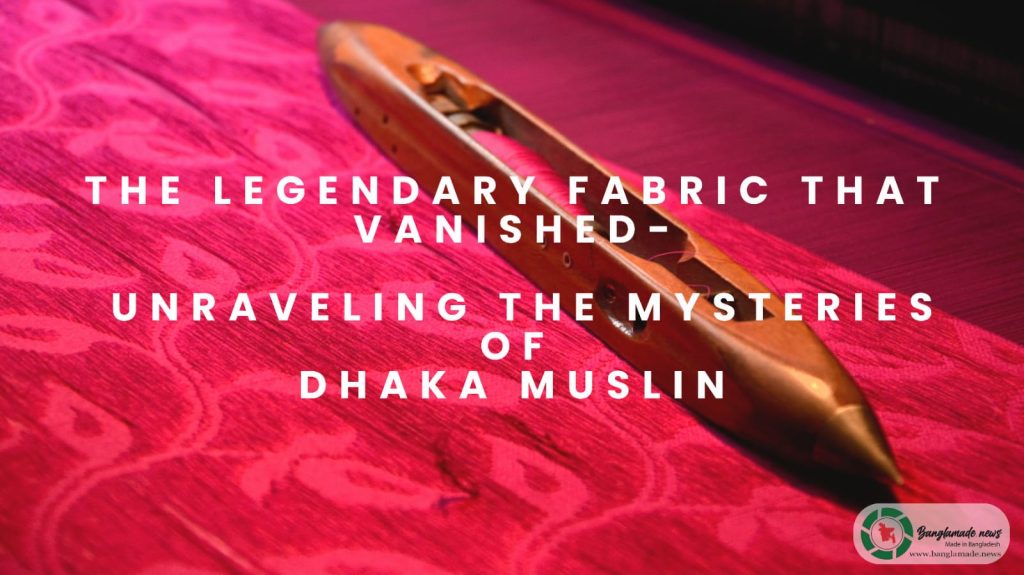
For centuries, Dhaka muslin was the most exquisite textile on earth. This diaphanous cotton fabric woven along the banks of the Meghna River was so light and softly fluid, it was said a full length could be pulled through a ring. Dhaka muslin was popular—among those with money. The French empress Joséphine Bonaparte, Jane Austen, and the French monarch Marie Antoinette were among its retinue of devoted devotees. It was the most expensive cloth of the time. But as fast as it appeared in Europe during the Age of Enlightenment, this wonder textile disappeared.
Yet by the early 20th century, true Dhaka muslin had disappeared altogether, leaving the elaborate techniques behind its production forever lost. How did this happen? And could this legendary fabric ever be brought back?
Dhaka muslin originated in what is now Bangladesh. Its delicate threads came from a rare local cotton called Phuti karpas that grew nowhere else. Spun by skilled artisans under specific conditions, the threads were then woven into intricate jamdani patterns in a painstaking 16-step process spread across villages. Since the short cotton fibers needed a lot of humidity to stretch, this stage was carried out on boats by knowledgeable teams of young women during the morning and afternoon, when it was the wettest of the day. Because they could not see the threads, older folks typically were unable to spin the yarn. The result was a luxurious cloth of unparalleled quality, with astonishing thread counts up to 1,200, most versions made today have thread counts between 40 and 80.
Customers from the West had a hard time believing that Dhaka muslin was actually manufactured by people because it was said that mermaids, fairies, and even ghosts wove it. Some claimed it was carried out underwater. It was like nothing we have today because of how light and soft it was.
Everything seemed to be progressing smoothly until the British intervention disrupted the course of events. By 1793, the British East India Company had established dominion over the Mughal empire, and within a span of less than a century, the region had fallen under the rule of the British Raj.
In 1793, British rule was established following the East India Company’s conquest of the Mughal empire. Dhaka muslin made its UK debut at the 1851 Great Exhibition, where 100,000 artifacts adorned the splendid Crystal Palace, a showcase of British Empire opulence.
During that era, a yard of Dhaka muslin fetched £50-£400 (equivalent to £7,000-£56,000 today). While Victorians admired it, makers grappled with debt due to the East India Company’s alterations to the manufacturing process. Traditional customers were swapped for those from the British Empire, tightening control and pressuring weavers for higher output at lower costs. Converting Phuti karpas into cloth demanded specialized skills and a labor-intensive process, yielding a mere eight grams of muslin from a kilogram of cotton.
As weavers struggled and fell into debt, their situation worsened. Upfront payment for a year-long cloth-making process left them vulnerable to full repayment if standards fell short. Competition was the final blow. Colonial entities, including the East India Company, meticulously studied and replicated the muslin industry’s steps, hastening its decline.
Today, the few surviving Dhaka muslin samples are conserved in museums. The weaving village traditions continue, but only at reduced quality. The mystery of the fabric’s lost techniques has captivated historians and fashion enthusiasts alike. However, a dedicated project known as Bengal Muslin has taken the first steps in reviving true Dhaka muslin.
After sequencing the DNA of preserved Phuti karpas leaves, the Bengal Muslin team traced the Meghna’s historic course to find wild cotton plants that could be descendants. Meticulous testing identified a suitable match containing traces of the original cotton’s genome. Painstaking work to selectively breed this cotton is now yielding authentic Phuti karpas once more.
The first hybrid Dhaka muslin saris combining new Phuti karpas with regular cotton have already been woven and exhibited worldwide. The project also aims to recreate the traditional spinning and weaving expertise to produce true Dhaka muslin again. Though still far from the unfathomable quality of the past, this endeavour kindles hopes of bridging generations and rediscovering textile perfection.
The story of Dhaka muslin epitomizes mastery, exploitation and revival. Its peerless finesse came from centuries of artistry and was shattered by industrial greed. Yet somehow, through today’s devotion, a glimmer of its splendor may still return, like gossamer threads shimmering back through time. The ancient fabric waits in the silver Meghna waters, ready to be woven into magic once more.
